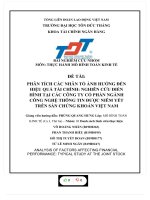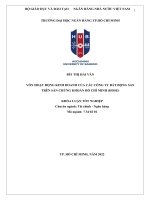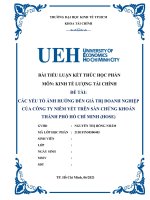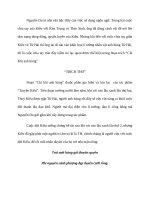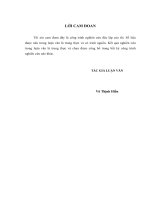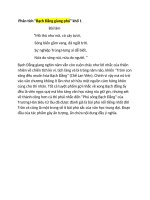PHÂN TÍCH các NHÂN tố ẢNH HƯỞNG đến HIỆU QUẢ tài CHÍNH NGHIÊN cứu điển HÌNH tại các CÔNG TY cổ PHẦN NGÀNH CÔNG NGHỆ THÔNG TIN được NIÊM yết TRÊN sàn CHỨNG KHOÁN
Bạn đang xem bản rút gọn của tài liệu. Xem và tải ngay bản đầy đủ của tài liệu tại đây (728.18 KB, 21 trang )
TỔNG LIÊN ĐỒN LAO ĐỘNG VIỆT NAM
TRƯỜNG ĐẠI HỌC TƠN ĐỨC THẮNG
KHOA TÀI CHÍNH NGÂN HÀNG
BÀI NGHIÊM CỨU NHĨM
MƠN: THỰC HÀNH MƠ HÌNH TỐN KINH TẾ
ĐỀ TÀI:
PHÂN TÍCH CÁC NHÂN TỐ ẢNH HƯỞNG ĐẾN
HIỆU QUẢ TÀI CHÍNH: NGHIÊN CỨU ĐIỂN
HÌNH TẠI CÁC CÔNG TY CỔ PHẦN NGÀNH
CÔNG NGHỆ THÔNG TIN ĐƯỢC NIÊM YẾT
TRÊN SÀN CHỨNG KHOÁN VIỆT NAM
Giảng viên hướng dẫn: PHÙNG QUANG HƯNG
Lớp: MƠ HÌNH TỐN KINH TẾ (Ca 3, Thứ ba) – Nhóm: 03
Danh sách Sinh viên thực hiện:
VÕ HOÀNG NHÂN (B19H0263)
PHAN THANH HIẾU (B19H0195)
HỒ THỊ TUYẾT ĐOAN (B19H0177)
TỪ LÊ MINH NGÂN (B19H0247)
ANALYSIS OF FACTORS AFFECTING FINANCIAL
PERFORMANCE: TYPICAL STUDY AT THE JOINT STOCK
0
0
COMPANY LISTED INFORMATION TECHNOLOGY ON
VIETNAM STOCK EXCHANGE
ABSTRACT:
The objective of the study is to examine the factors that affect the financial performance
of the companies from which to make some suggestions for managers to improve
financial performance. The study used data from 22 companies that share the
information technology sector listed on stock exchanges in Vietnam period 2007-2018 in
the field of information technology. The research results have shown that the effectiveness
main (ROA) of companies significantly affected by the ratio of the state capital (STATE),
the management capacity (MC), firm size (SIZE), and the company's business cycle (BS).
On the other hand, the study also pointed out the positive impact (+) of ROA on the
profitability ratio on equity (ROE).
Keywords: Production cycle business, financial performance, the company shares listed
information technology industry.
1. INTRODUCTION:
Today, technology is proliferating,
especially in information technology
have an important role in bringing a new
era of modern advanced technologies
worldwide,
including
Vietnam.
Therefore, need to understand the factors
affecting financial performance and this
will be the baggage to participate in the
market in this area, most notably as
ROA, ROE, MC, SIZE, STATE, BS, CR,
QR, and DFL. Vietnam's stock market in
the period 2011-2013 continuously
fluctuated strongly, seriously affecting
companies. Two factors may explain this,
which is endogenous and exogenous in
which one of the endogenous factors is
very important that the financial
performance of companies. When
analyzing the research and data
companies in the information technology
industry, we discovered that there are
companies with negative profits after tax
during 2011, 2012, and 2013. For
example, the company technical Services
Joint-stock Telecommunications (TST),
JSC Telecommunications (UNI), JSC
VITECO
Telecommunications
technology (VIE) ... However, there are
companies with profits after higher taxes
or even flourished during that period. For
example,
Van
Lang
Technology
Development and Investment Joint Stock
Company (VLA), Vietnam Electronics
and Informatics Corporation (VEC), ...
This leads to the question: What factors
affect the financial performance of the
company shares listed on the stock
exchange in Vietnam? If so, how many
factors? In addition, the level of impact
like?
The research focused on studying the
factors that affect the financial
performance of the listed joint-stock
2|Page
0
0
3|Page
0
0
4|Page
0
0
5|Page
0
0
Table 0. The previous related research
Author
Research method and sample
Investigate the factors affecting the
profitability
and
growth
of
employment in the manufacturing
Agiomirgiannakis, G., sector of Greece in the period from
Voulgaris, F. and
1995 to 1999, analyzing the question
Papadogonas, T. (2006) of whether factors such as company
size, age, leverage debt, management
efficiency,
and
export-oriented
companies
Research results
Factors such as the
size of a company
and economic ratios
that
affect
the
growth
of
the
company
in
particular and the
national economy in
general
Determinant of bank profitability
If company size is
too large, it can
harm
financial
performance due to
poorly controlled or
even corruption
Based on the disclosure of timely
annual reports to confirm and modify
their expectations about the current
economic outlook and the future of
the company
Factors affecting the
financial
performance of the
company
Based on the disclosure of timely
Almajali, Y.A, Alamro, annual reports to confirm and modify
S.H. and Al-Soub, Y.Z. their expectations about the current
(2012)
economic outlook and the future of
the company
Factors affecting the
financial
performance
of
insurance companies
in Jordan listed in
Amman
Stock
Exchange
Yuqi, L. (2008)
Liargovas and
Skandalis (2008)
companies listed on Vietnam's stock
exchanges, more precisely Corporation
Information Technology. The team used
the method of correlation analysis and
6|Page
0
0
multiple regression analysis. Strictly
research also indicates factors the state
capital ratios, company size, ratio of
capacity management, business cycle
strong impact on financial performance.
Moreover, the group is strictly between
the ROA and ROE depth.
The layout of the study will include:
I. Introduction
II. Basic theory
a. The previous related research
b. The concept and meaning of each
financial indicators used in the study
III. Data and research methods
IV. Research model, research hypotheses
b. The concept and meaning of each
financial indicators used in the
study
If the financial performance measures
are a common and important concept and
meaning of each financial indicators
used in this study is what? And why they
need to analyze the company shares
information
technology
financial
performance on the stock market.
i.
Return on Asset (ROA)
ROA (Return on Assets) - it is the return
on assets, an indicator showing the
correlation between the profitability of a
company compared to its main assets.
ROA gives to know the effectiveness of
the company is using assets to generate
earnings.
ROA =
V. Research results
VI. Conclusions and recommendations
VII. References
2. BASIC THEORY
a. The previous related research
Financial performance important role for
businesses in particular and the economy
in general. There are many studies on
financial performance and the factors
affecting it. Search gives different
figures on financial performance but the
main index was ROA, ROE, MC, SIZE,
STATE, BS, CR, QR, and DFL, the
popularity index for measuring the
competitiveness of the company's ROA
and ROE.
Table 0. The previous related research
ROA shows that a business has invested
how much profit on assets. The higher
the ROA, the use of corporate assets
more effectively.
ii.
Return On Equity (ROE)
ROE (Return On Equity) - it is the return
on equity, and return on equity also. If
the analysis, there will be a lot of
interesting information about the
business results as well as the financial
picture of the business behind this
indicator.
ROE =
ROE shows one pile of equity which
now spent to serve activity, how much
profit. The higher the ROE, the use of
corporate funds as efficiently.
7|Page
0
0
iii.
The size of business (SIZE)
Large companies can exploit economies
of scale and therefore more efficient than
small companies. The size of a business
can be evaluated based on criteria such
as the total number of employees, total
revenue, or total assets.
Company size is calculated by total
assets is measured
Moreover, small companies may have
less energy than large companies can
because they are difficult to compete
with larger companies, especially in a
highly competitive market. On the other
hand, when companies become larger,
they may be ineffective, leading to
reduced financial performance.
iv.
Management competence in an
index (MC)
Management competence in an index
(MC) is an indicator of leadership and
supervision of the management level in
the company.
MC =
It may include the ability to plan and
divide the work efficiently, respond
quickly to solve the problem, have indepth knowledge and skills necessary
software.
v.
Business cycle (BS)
Business cycle (BS) is the period from
when the raw materials are put into
production until the finished product
fabrication, inspection, and storage of
finished products. It includes the time to
complete the work in process
technology; time to deliver; technical
testing time; work in progress stops at
work, in the intermediate repository, and
non-production shifts.
BS = Turnaround time inventory +
Turnaround time accounts receivables
Shorter production cycles, which
indicates how efficient the use of
machinery and production areas.
Production cycles affect working capital
needs and the effective use of working
capital in production. In competitive
markets, production cycles shorter
change the ability of the production
system as possible to respond to the
changes. Moreover, trade receivables
faster turnaround, the company recover
the debt faster, increasing capital
turnover, reduce costs related to accounts
receivable. The dual impact of the
shortened business cycles increases
profitability.
vi.
Degree Of Financial Leverage
(DFL)
Degree Of Financial Leverage (DFL) is a
combination between liabilities and
equity in the management of the
financial policy of the enterprise.
DFL=
Degree Of Financial Leverage is the
degree of use of loans in the total capital
of a company in the hope of increasing
return on equity (ROE), or earnings per
ordinary share (EPS).
vii.
Quick raito (QR)
Quick ratio (QR) is an indicator of the
short-term liquidity position of the
8|Page
0
0
company and measures the ability to
meet the short-term obligations of the
company with its liquid assets.
QR =
It shows the ability of the company to
immediately use assets almost his cash
(assets that can be converted quickly into
cash) to pay the debts of your current, it
is also known as the acid test ratio.
viii. Current ratio (CR)
Current ratio (CR) is the ratio of liquidity
solvency measure short-term obligations
of the company or the obligations due
within one year.
CR =
It gives investors and analysts to know
how a company can maximize existing
assets on the balance sheet accounting to
meet its current liabilities and other
payables.
3. DATA AND RESEARCH
METHODS
Research samples are 22 joint-stock
companies in the information technology
sector listed on stock exchanges period
2007 - 2018. Group uses the information
gathered from the report prospectus,
financial reports, and information on the
companies on the website of the
company and the site CafeF, Vietstock,
cophieu68.
The data analysis method used in the
study is the ratio method. Analyzing
financial ratios is the use of various
techniques to analyze the financial
statements of the enterprise to grasp the
situation of the financial realities of the
business, which made plans for
production and business most effective
for calculating the ratios measuring the
financial performance (ROA, ROE),
business cycle (BS) Degree of Financial
Leverage (DFL) and the proportion of
the state capital (state) and the
percentage measure the impact of factors
such as solvency (QR, CR), capacity
management committee (MC).
+ Advantages: it evaluates the efficiency
and performance of the company's
business operations, evaluates the
efficiency of the use of company
resources. The ratio of financial
structure: reflects the extent to which
businesses use to paying off debt reflects
the degree of financial autonomy of
enterprises. Moreover, it also guides the
forecast and plans production and
business activities, investment decisions
and funding to deal with the financial
markets determine the risks and profits.
+ Disadvantages: we cannot recognize
inaccurate financial statements. The time
element is not mentioned and is difficult
to conclude the financial situation good
or bad. Moreover, the planning could not
feasible
for
the
business's
multidisciplinary activities.
Besides, the group also uses statistical
analysis methods. Statistics is a system
of methods (collecting, synthesizing, and
presenting data, and calculate the
characteristics of the object of study) to
cater for the analysis, prediction, and
decision making. Purpose cranes Group
9|Page
0
0
was to examine the relationship between
the dependent variable and the
independent variables, the paper uses the
statistical method described, correlation
matrix,
check
the
phenomenon
autocorrelation
(Durbin-Watson),
multiple regression method and multicollinearity test.
4. RESEARCH MODEL AND
RESEARCH HYPOTHESES
a. Research model
Based on research and the reality of
Vietnam, offering theoretical models are:
ROA = β0 + β1*STATE+ β2*CR+
β3*DFL+ β4*MC+ β5*SIZE+
β6*BS+ β8*QR+ ε (1)
ROE = β0 + β1*ROA+ ε (2)
ROA: Return on total assets
ROE: Return on equity
STATE: State capital ratio
DFL: Degree of Financial Leverage
MC: Management competence index
SIZE: The size of the company
BS: Business cycle
QR, CR: Short-term solvency
b. Research hypotheses
i.
Financial performance
The business performance of the
enterprise is a general economic
indicator that reflects the level of use of
the elements of the production process.
Business performance is also reflected in
the maneuver of the corporate
governance between theory and practice
to make the most of the weakness of the
manufacturing
process,
such
as
machinery and equipment, raw materials,
labor to improve profitability. Overall
ROS, ROA, ROE is a measure used the
three most popular in assessing the
financial performance of the business. In
this study, the group will mainly use
ROA and ROE to assess the financial
performance of the companies that share
industry information technology listed on
Vietnam's stock by these indicators may
reflect how to look past, shows the
operation of the enterprise business-like.
Besides, these indicators also help us
have a look at easy ways to compare
businesses together. Moreover, the final
objective of financial management is to
maximize the benefit of the owner so
that after examining the factors affecting
the ROA, the authors examine the impact
of ROA over ROE.
ii.
Short-term solvency (QR & CR)
To measure the short-term solvency of
researchers usually use the current ratio
(CR) and quick ratio (QR). Solvency
impacts on financial performance in
detail: According to Almajali et al
(2012), Maleya and Muturi (2013), the
solvency relationship the same way with
financial performance. But conversely,
Khalifa and Zurina (2013) indicate
solvency opposite impact on financial
performance. So the research hypothesis
pair is given as:
H01: Short-term solvency does not affect
financial performance
H11: Short-term solvency
financial performance
affects
10 | P a g e
0
0
iii.
Degree of Financial Leverage
(DFL)
Degree of Financial Leverage refers to
the use of debt in the capital structure of
the company. The Degree of Financial
Leverage is one of the important
decisions of financial managers because
it is a double-edged sword and affects the
benefits and risks of the owner as well as
the market value of the company.
Besides, many researchers consider the
impact of the degree of financial
leverage on financial performance in
detail: Ghosh, Nag and Sirmans (2000),
Berger and di Patti (2006) in his study
had indicated the degree of financial
leverage has a positive impact on
financial performance, but on the
contrary, Gleason et al (2000), Simerly
and Li (2000), Maleya and Muturi
(2013) in his study again indicates the
negative impact of the degree of
financial
leverage
to
financial
performance. The hypothesis is given as:
H02: Degree of financial leverage has no
impact on financial performance
H12: Degree of financial leverage has an
impact on financial performance
iv.
The size of the company (SIZE)
Company size has measured the size of
total assets. Enterprise-scale is one of the
first criteria to the company affirmed its
position in the sector and attract
investments of investors. Ammar et al
(2003), Amato and Burson (2007),
Liargovas and Skandalis (2008), Lee
(2009), Amalendu (2010), Almajali, et al
(2012) showed the impact of firm size
and efficiency finance. These studies
present conflicting views on the
relationship between size and financial
performance. However, the opposite
view that the scale has a relationship
inversely to the financial performance
due to some problems with corruption
and several other reasons: operating
inefficiencies due to poor control. The
hypothesis is given as:
H03: Company size does not affect
financial performance
H13: Company size has an impact on
financial performance
v.
Business cycle (BS)
A company's business is the period from
when a company buys goods to when the
company sells goods and collects money.
The company's business cycle shorter,
shorten the turnaround time and
inventory turnaround time, the accounts
receivable
increasing
financial
performance. The main reason due to
goods sold faster, less storage time,
increasing sales, reducing costs of
inventory investment. Moreover, trade
receivables faster turnaround, the
company recover the debt faster,
increasing capital turnover, reduce costs
related to accounts receivable. The dual
impact of the shortened business cycles
increases profitability. So the hypothesis
is given as:
H04: Business cycle has no impact on
financial performance
H14: Business has an impact on financial
performance
11 | P a g e
0
0
vi.
State capital ratio (STATE)
The state capital ratio is measured by the
percentage of state capital in total equity.
The joint-stock company listed on the
stock market and have long years of
operation of most of the large-scale
capital mainly been equitized. So the
hypothesis is given as:
H05: The ratio of state capital has no
impact on financial performance
H15: The ratio of state capital has an
impact on financial performance
vii.
Management competence index
(MC)
According
to
Timmons
(1994),
successful companies have a significant
contribution to the skills and creativity of
managers. Bird (1995) also pointed out
that the capacity to manage a strong
impact on the financial performance and
operational efficiency of the company.
These successful companies are those
companies that have managers capable
of "core" - the ability to combine the
knowledge, experience, expertise, and
skills to the executive management team
to achieve the objectives of Co. (Coyne,
Hall and Clifford, 1997). According to
MaMerikas et al. (2006), “professionals”
are managers who meet the following
two criteria: (1) Have a university degree
and (2) Direct management or be part of
the management team. (management
team). According to Liargovas and
Skandalis (2008), a company has a
management team when it satisfies at
least three of the following five
conditions: (1) The average managerial
experience is 20 years, (2 The
management group holds an average of
34% of the company shares, (3) Most
managers in the university graduate
group (4) Average age of managers in the
group from 50 to 60 years old, ( 5) All
managers in the group undertake
innovation activities - an innovation that
refers to the introduction of new
products, new production technologies,
new market developments or reforms of
organizational structure. function in the
company. The hypothesis is given:
H07: Management competence index has
no impact on financial performance
H17: Management competence index has
an impact on financial performance
5. RESEARCH RESULTS
a. Descriptive statistics
In Table 1, the Descriptive Statistics
provide data minimum, maximum and
average, the standard deviation of the
independent variables and the dependent
variable of 22 companies share industry
information technology on the Stock
Exchange in the period 2007 to 2018,
with observation is 80. production and
business cycle (BS), an average of about
309 days. The short-term solvency of the
company average (CR) is about 2.79
times. Degree of financial leverage
(DFL) average 0.42 times. The ratio of
management capacity (MC) averaged
about 1,261 billion VND. Quick ratio
averaging time is 2:04. Rate of Return on
total assets (ROA) 3.8% average in 12
years and the profitability ratio on
average equity 7.2%. The average
12 | P a g e
0
0
company size (SIZE) is about 552,354
billion VND. The proportion of state
ownership (STATE) average about
12.5%.
b. Check correlation
In Table 2, the variables include the
production and business cycles (BS),
ratio management capacity (MC) have a
significant impact on the financial
performance ROA. MC impact the same
way with financial efficiency, while BS
opposite impact financial performance.
13 | P a g e
0
0
BS
CR
DFL
MC
QR
ROA
ROE
SIZE
STATE
Table 1. Descriptive Statistics variables
Mean
Minimum Maximum Std. Deviation Observation
308.275
47.647 1243.352
212.482
80
2.790
1.148
25.688
3.303
80
0.424
0.007
0.861
0.221
80
1.261
-5.838
9.037
2.233
80
2.038
0.512
17.425
2.526
80
0.038
-0.121
0.193
0.056
80
0.072
-0.309
0.324
0.099
80
552.354
70.336 2983.032
688.897
80
0.125
0
0.590
0.155
80
Table 2. Matrix correlation between ROA and the independent variables
ROA
Correlation
Probability
BS
-0.388
0.000
CR
QR
0.279 0.234
0.012 0.036
DFL
-0.274
0.013
MC
SIZE STATE
0.518 -0.013
-0.293
0.000 0.907
0.008
14 | P a g e
0
0
multi-collinear when the VIF ratio
greater than 10. In Table 4, the
coefficient of variation from 1,165 VIF
to 4114 to model the phenomenon of no
multi-collinearity
between
the
independent variables.
c. Test of the standard distribution
To estimate the linear regression to
consider the variables have normal
distribution or not. Initially, when
examining several variables such as
DFL, SIZE, MC, BS, QR are not
e. Check autocorrelation
normally distributed variables so the
To examine the serious autocorrelation
group moved into the natural logarithm
often used at the Durbin-Watson test, if
function. After using this method, it is
the coefficient of Durbin-Waston in the
almost all the variables was transformed
region from 1 to 3 there will be no selfinto a normal distribution with the data
correlation
phenomenon.
Through
in Table 3 is located.
Durbin-Watson test data on Eview8
Table 3. Check the normal distribution
STATE
Skewnes
s
Kurtosis
1.030
CR
LNDFL ROA LNSIZE LNMC LNBS LNQR
5.218
-1.998 1.302
0.779
3.261 32.637
LNBS
8.853 3.656
3.233
LNQR
LNMC
LNDFL
d. Multi-collinearity test
Regression analysis to correlate the first
group will examine the phenomenon of
multi-collinear
with
expertise
Collinearity Statistics. The independent
variables will have the phenomenon of
-0.433 -0.428
2.801
1.771
2.497 7.282
LNSIZE
VARIABLES
HAVE
CONVERTED TO
NATURAL LOGA
FUNCTION
software with D = 1.582 (Table 5), the
model
has
no
autocorrelation
phenomenon.
Table 4. Verification of multi-collinearity phenomenon
VIF
STATE
1.165
CR
LNDFL LNSIZE LNMC
3.552
2.729
1.866
2.893
0
0
LNBS
2.037
LNQR
15 | P a g e
4.114
Table 5. Test of Anova and Durbin-Watson
R-squared
Adjusted R-squared
S.E of regression
Sum squared resid
Log likelihood
F-statistic
Prob(F-statistic)
0.763673
0.736554
0.024897
0.037812
161.1615
28.15958
0.000000
f. Multiple Regression
i.
Inspection of the suitability of the
model ROA
We have R-Square = 0.763 (Table 5) is
the mean of independent variables was
76.3% which explains the change of
financial performance. Besides, through
accreditation
A-nova
on
the
appropriateness of the model and may
find this model perfectly suited to
consider the impact of the independent
variables to effectively finance at (Pvalue = 4.72% <5%).
ii.
A multiple regression model of
ROA and explain its meaning
After checking the normal distribution,
the autocorrelation test and multi-
Mean dependent var
S.D. dependent var
Akaike info criterion
Schwarz criterion
Hanna-Quinn criter
Durbin-Waston stat
0.047279
0.048507
-4.439463
-4.180436
-4.336699
1.582219
collinearity test team used multiple
regression analysis to examine the
relationship between the dependent
variable and independent variables.
(Table 6)
- State capital ratio (STATE): P-value =
1.94% <5% can reject the hypothesis H0
or the rate of state capital has an impact
on financial performance and has a
negative impact (-) at a 5% significance
level. Companies with large-scale state
capital will have solid financial
resources, scale, and the protection of the
state of the outputs. In addition, for
companies in the sector telematics with
the proportion of equity capital high state
will have products and services to the
Table 6. The multiple regression model of ROA
Variable
Coefficient
Std. Error
t-Statistic
Prob.
C
0.267
0.033
7.957
0.0000
STATE
-0.054
0.022
-2.401
0.0194
CR
-0.003
0.002
-1.592
0.1166
LNDFL
-0.008
0.006
-1.407
0.1644
LNMC
0.028
0.004
7.227
0.0000
LNSIZE
-0.026
0.005
-5.576
0.0000
LNBS
-0.011
0.005
-2.100
0.0399
LNQR
0.006
0.009
-1.592
0.5658
ROA = 0.267 – 0.054*STATE – 0.003*CR – 0.008*LNDFL + 0.028*LNMC –
0.026*LNSIZE – 0.011*LNBS + 0.006*LNQR
16 | P a g e
0
0
public post for mutual interest leads to
profits is maximized. Moreover,
companies with state capital have been
high, the profits also belong to the state,
businesses and just enjoy a fixed rate.
Therefore, the state invested the greater
the profit achieved at low levels.
- Management Competency Ratio
(LnMC): P-value is very small and less
than 5% which means is enough to reject
the hypothesis H0 or the ratio of the
capacity of the management of the
company has an impact on performance.
finance. On the other hand, the ratio of
the capacity of the Management Board
with effect positive (+) to the financial
performance, is consistent with severe
early work of Timmons (1994), Bird
(1995), Liargovas and Skandalis (2008),
Almajali et al (2012), ... with companies
in the field of information technology
leaders needed a deep understanding of
technology and creativity they needed
for work, only some very needed in this
field.
- Company size (LnSIZE): the size of the
company p-value <5%, company size has
a significant impact on the financial
performance of the company and the
impact
counterclockwise
(-)
for
effectiveness main. This is consistent
with the serious research on the
relationship between the size of Ammar
et al (2003), Amato and Burson (2007),
Lee (2009), ... indicate the financial
performance decreases as firm size
increases. When the size of the company
is enhanced, the control process becomes
complex, difficult to manage, this leads
to corruption and some other reasons.
For the field of information technology,
while increasing the size of the company,
the personnel should raise the level to
adapt to the new equipment and
software.
- Business production cycle (LnBS): This
index has a negative impact (-) on
financial performance and is statistically
significant at 5%. Thus, this is fully
consistent with the theory. For
companies in the fields of information
technology to manage two types of
mobile assets (inventories and trade
receivables) faster turnaround will help
companies shorten the production cycle
of business because of business in this
area, there are many electronic devices
very fast depreciation should shorten the
production cycle of business. Since then,
the company will save the investment
costs and the cost of inventories, trade
receivables management, and increase
profits.
iii.
Regression model ROE and ROA
In Table 7, a significant impact ROA
ROE (return rate of equity and earnings
per share) with p-value <5%. Besides, Rsquared is meant 0767 was 76.7% ROA
explains the change in ROE. Moreover,
we can see the positive impact of ROA
Table 7. Simple regression between ROE and ROA
Variable
C
ROA
Coefficient
Std. Error
t-Statistic
0.011
0.004
2.273
2.085
0.075
27.858
R-squared
0.766819
ROE = 0.011 + 2.085*ROA
0
0
Prob.
0.0239
0.0000
17 | P a g e
(+) with ROE. As a result, an increase in
ROA increases ROE.
6. CONCLUSIONS
AND
RECOMMENDATIONS
Research by the group has shown that
STATE, MC, SIZE, BS have a significant
impact on financial performance. In it,
STATE, SIZE, BS harms financial
performance or companies sector
information technology wants to increase
financial efficiency need to shorten the
production cycle of business by
managing inventory and customer
receivables more efficiently, it will
reduce the turnaround time of two types
of assets. Moreover, to improve the
financial performance of the company
should focus on increasing the capacity
of management. Besides, serious also
found no relationship in the same
direction between the ROA and ROE, to
increase the profitability ratio of equity
companies should adopt strategies to
increase their ability to generate profits
of assets.
7. REFERENCES
Agiomirgiannakis, G., Voulgaris, F. And Papadogonas, T. (2006), ‘Financial factors
affecting profitability and employment growth: the case of Greek manufacturing’, Int.
J. Financial Services Management, Issue 1, volume 2/3, pages 232 - 242.
Amalendu, Bhunia (2010), ‘Financial Performance of Indian Pharmaceutical
Industry: A Case Study’, Asian Journal of Management Research, Issue 1, volume
2, page 427-451.
Ammar, A., Hanna, A.S., Nordheim, E.V. andRussell, J.S. (2003), ‘Indicator Variables
Model of Firm's Size-Prof- itability Relationship of Electrical Contractors Using
Financial and Economic Data’, Journal of Construction Engineering and
Management, No. 129, page 192-197.
Amato, L.H. and Burson, T.E. (2007), ‘The effects of firm size on profit rates in the
financial services’, Journal of Economics and Economic Education Research,
Issue 8, volume 1, page 67-81.
Almajali, Y.A, Alamro, S.H. and Al-Soub, Y.Z. (2012), 'Factors Affecting the Financial
Performance of Listed Companies at Amman Jordanian Insurance Stock
Exchange', Journal of Management Research, Issue 4, Volume 2, page 226- 289.
Berger, A. N and di Patti, E.B (2006), ‘Capital Structure and Financial performance:
A New Approach to Testing Agency Theory and an Application to the Banking
Industry’, Journal of Banking and Finance, No. 30, page 1065-1102
Bird, B. (1995), ‘Toward a theory of entrepreneurial competency.’ In J.A.Katz (ed)
Advances in Entrepreneurship, Firm Emerence, and Growth, Greenwich, CT: JAI
Press 2, page 52–72.
18 | P a g e
0
0
Coyne, K.P., Hall, J.D. and Clifford, P.G. (1997), ‘Is your Core Competence a
Mirage?’, The McKinsey Quarterly, Issue 1, Page 40-45.
Ghosh, C., Nag, R., and Sirmans, C. (2000), ‘The pricing of seasoned equity offerings:
Evidence from REITs’, Real Estate Economics, Issue 28, page 363-384.
Gleason, K., Mathur, L. and Mathur, I. (2000), ‘The interrelationship between culture,
capital structure, and perfor- mance: Evidence from European retailers’, Journal
of Business Research, Issue 50, page 185-191.
Hart, S. L. and Ahuja, G. (1996), ‘Does it pay to be green? An empirical examination
of the relationship between emission reduction and firm performance’, Business
Strategy and the Environment, Issue 5, page 30-37.
Khalifa, M.K. and Zurina, S. (2013), ‘Financial Performance and Identify Affecting
Factors in this Performance of Nonoil Manufacturing Companies Listed on
Libyan Stock Market (LSM)’, European Journal of Business and Management,
Issue 5, Volume 12, page 82-89.
Konar, S. and Cohen, M. A. (2001), ‘Does the Market Value Environmental
Performance?’, Review of Economics and Statistics, Issue 83, Volume 2, page
281-309.
Russo, M.V. and Fouts, P.A. (1997), ‘A resource-based perspective on corporate
environmental performance and profitability’, Academy of Management Journal,
Issue 40, Volume 3, page 534–559.
Liargovas, P. and Skandalis, K. (2008), ‘Factor affecting firms’ financial performance:
The Case of Greece’, American Economic Review, Issue 48 page 261-297.
Lee, J. (2009), ‘Does Size Matter in Firm Performance? Evidence from US Public
Firms’, Int. J. of the Economics of Business’, Issue 16, Volume 2, page 189-203.
McGuire, J. B., Sundgren, A. and Schneeweis, T. (1988), ‘Corporate social
responsibility and firm financial performance’, Academy of Management Journal,
Issue 31, Volume 4, page 854- 872.
Maleya, M.O. and Muturi, W. (2013), ‘Factors Affecting the Financial Performance of
Listed Companies at the Nairobi Securities Exchange in Kenya’, Research Journal
of Finance and Accounting, Issue 4, Volume 15, page 99-104.
Tarawneh, M. (2006), ‘A Comparison of Financial Performance in the Banking
Sector: Some Evidence from Omani Commercial Banks’, International Research
Journal of Finance and Economics, Issue 3, page 103-112.
19 | P a g e
0
0
Simerly, R. andLi, M. (2000), ‘Environmental dynamism, financial leverage and
performance: A theoretical integration and an empirical test’, Strategic
Management Journal, Vol. 21, volume 1, page 31-49.
Stanwick, S. andStanwick, P. (2000), ‘The relationship between environmental
disclosures and financialperformance: An empirical study of the US corporation ',
Eco-Management and Auditing, No. 7, page 155-164.
Timmons, J.A. (1994), New Venture Creation: Entrepreneurship for the 21st Century,
4th edition. Irwin Press, Chica- go.
Yuqi, L. (2008), ‘Determinants of Banks’ Profitability and Its Implication on Risk
Management Practices: Panel Evidence from the UK ', PhD Thesis, The
University of Nottingham, UK.
Yuqi, L. (2008), 'The determinants of bank returns' and its implications for risk
management practices: Council evidence from UK', University of Nottingham, UK
20 | P a g e
0
0
company size (SIZE) is about 552,354
billion VND. The proportion of state
ownership (STATE) average about
12.5%.
b. Check correlation
In Table 2, the variables include the
production and business cycles (BS),
ratio management capacity (MC) have a
significant impact on the financial
performance ROA. MC impact the same
way with financial efficiency, while BS
opposite impact financial performance.
0
0
